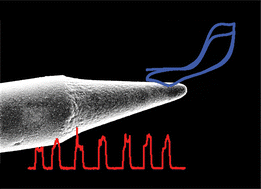An emerging research field in electrochemistry today is the preparation, characterization and application of diamond microelectrodes for electroanalytical measurements in biological media. Interest in this new electrode material stems from its outstanding properties: (i) hardness, (ii) low, stable and pH-independent background current, (iii) morphological and microstructural stability over a wide range of potentials, (iv) good electrochemical responsiveness for multiple redox analytes without any conventional pre-treatment and (v) weak molecular adsorption of polar molecules that leads to a high level of resistance to response deactivation and electrode fouling. Diamond electrodes have advanced in recent years from being simply a scientific curiosity into a viable material for electroanalysis. In this article, we highlight the current state of progress by our laboratory and others on the preparation, study of the basic electrochemical properties, and application of this new type of microelectrode for in vitro electroanalytical measurements, and discuss some of the remaining challenges.

You have access to this article
 Please wait while we load your content...
Something went wrong. Try again?
Please wait while we load your content...
Something went wrong. Try again?


 Please wait while we load your content...
Please wait while we load your content...